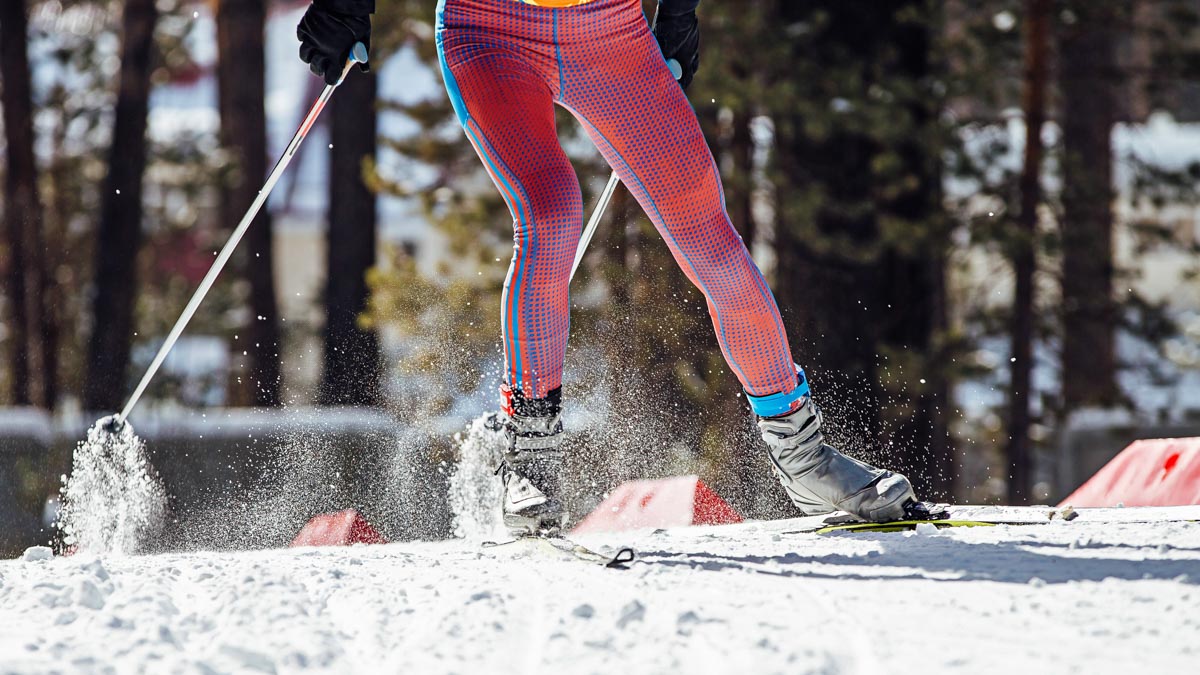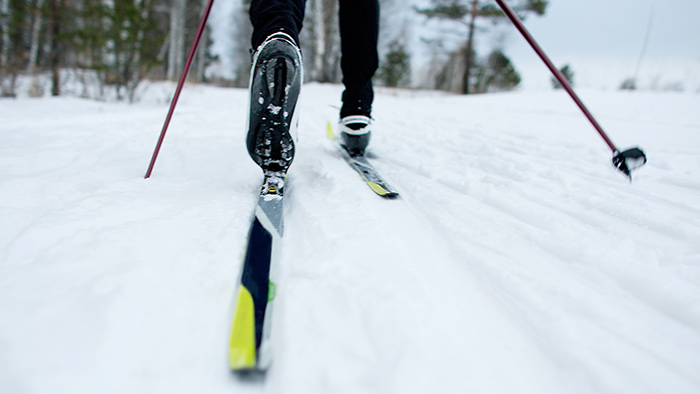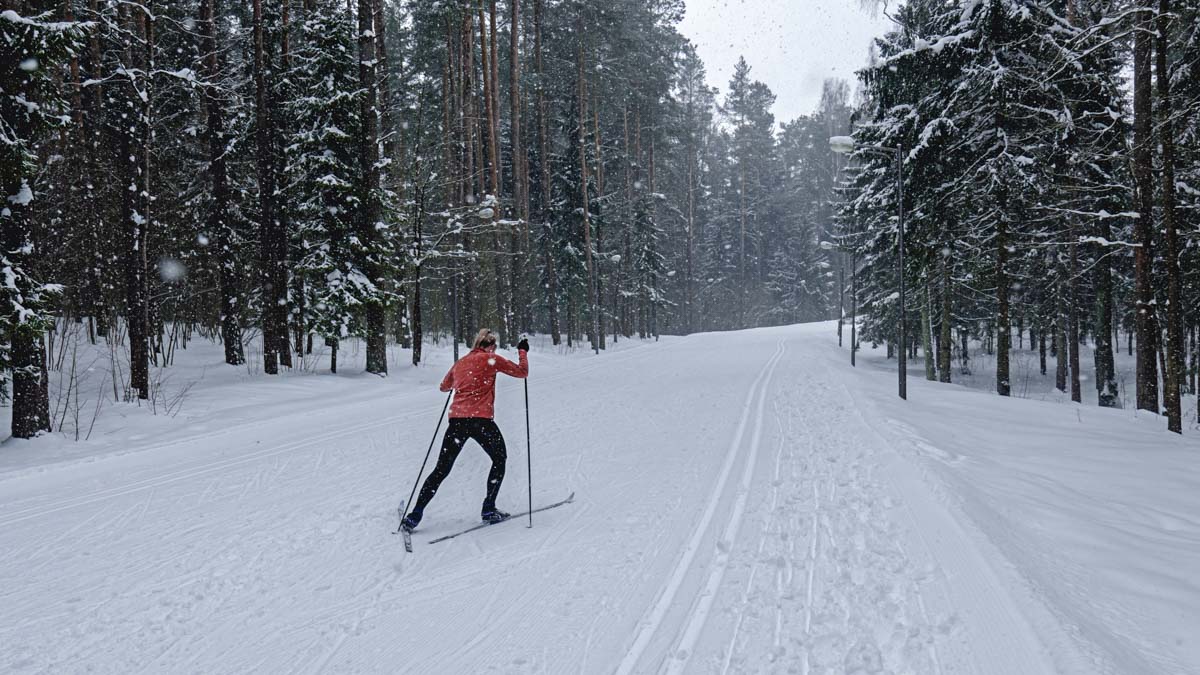Skate skiing is an invigorating and tremendously beneficial winter workout that every level of cold climate athlete can harness for off-season training. While it requires a groomed surface and a different set of equipment than the more traditional “classic” Nordic style, it is appealing because of the increased speed, the ease of maintenance, and the possibility for a variety of low-impact training.
History of Skate Skiing
The roots of the skate technique go back to the early 1980s when U.S. professional skier Bill Koch realized that the marathon skate — when a skier takes one ski out of the track and uses it to propel the other in-track ski forward using a single-sided skate motion — was actually a lot faster than the waxed, in-track diagonal stride traditionally used.
I came of age racing in this era in Alaska where my ski team bravely began waxing only the outside half of the wax pocket so that we could skate whenever it seemed fast. I still remember the conversation. Should we try it? It seemed risky at first but rapidly paid off. One season later, skate-specific skis with no kick wax pocket began to proliferate as companies tested technology to determine how to generate the most speed with the least resistance.
Fundamentals of Skate Skiing Technique
Because the skate-style ski has no kick wax or fish scales to grab the snow, propulsion comes from a combination of weight shift and body position, poling, and, finally, power, speed, and force. When learning how to skate ski, it is essential to understand body position and weight shift before moving on. Beginning without poles and understanding how to glide efficiently will lead to skiing with less resistance and more speed.
Try this progression of drills on flat, open, groomed terrain:
Drill 1: Understanding Body Position and Weight Shift
When beginning skate skiing, you must comprehend athletic body position, full weight shift, and how to transfer these onto a pair of fast sliding skinny boards attached to your feet. Mentally internalize the following progression as you begin.
- Start with skis off. Stand with your weight evenly distributed between both feet, arms loosely at your sides, spine neutral and comfortable with gaze ahead. “Soft stance” here — relaxed but not sloppy.
- Jump up and down and land softly. Notice how the balls of your feet strike first, and how your knees are slightly bent to cushion the landing.
- Finally, from an athletic starting stance, shift your weight from foot to foot in a rocking motion, keeping your legs straight but using hip shift to initiate the switch.
- Keep your gaze straight ahead, not down at your feet.
Repeat the entire routine with skis on thinking about
- soft knees
- keeping your gaze ahead up the trail
- full weight shift from ski to ski by rocking the hips, not bending the knee.
Remember that a stiff, upright skier falls easily while a relaxed, poised skier absorbs terrain changes with less issue.
For two optional drills to try with skis on, you can try hopping from foot to foot and running in place.
Drill 2: Learning Skate Motion Without Poles
- Stand with skis in a V position. Start with simple side-to-side weight transfer as explained above. Remember to shift from your hips without relying on bending your knee.
- Next, press your knees slightly forward toward the tip of the skis as you shift your weight to the balls of your feet. Your hips will move forward as your knees bend, and your skis will begin to move forward and away from each other. Either hop or bring one ski back to center once you’ve maxed out.
Once you’ve experimented, return to starting V and practice shifting weight from ski to ski. When you’re ready, apply the above and shift weight fully onto each ski as you move forward.
A Few Things to Remember
Many beginning skiers keep their weight centered between skis out of caution or fear starting out, and the habit can be hard to break. Your goal is to line up your nose, knee, and the tip of your ski in one line, with your shoulders squared over the ski. It’s okay to use your arms to assist in a speed skating motion. There is some poetry in the smooth transfer of weight from ski to ski when done right. Keep practicing until you feel smooth.
If you fall because you went too far out on a ski or glided too long, kudos! Taking the risk now and gliding long will help you later when you begin to incorporate poles and techniques for variable terrain.
Whenever you can, find an open, flat groomed loop or field to practice. Even after you’ve learned to incorporate poles, starting or finishing a ski workout without them will help you reinforce better balance and complete weight transfer.
For more advanced practitioners, try getting a group together to play freeze tag on skis. Taking risks, moving fast, and forgetting to think too much can be a great way to grow comfortable on your new skis.








